Catalog
Preface
brick : Neuron
A simple example
Encode a neuron
Assemble neurons into a network
Example : feedforward
Coding neural network : feedforward
Training neural network The first part
Loss
Examples of loss calculation
Code :MSE Loss
Training neural network The second part
Example : Calculating partial derivatives
Code : A complete neural network
The latter
We use Python Implement a... From scratch neural network To understand the principle of Neural Networks .
First, let's look at the basic units of Neural Networks , Neuron . Neurons accept input , Do some data operations on it , And then produce output . for example , This is a 2- Input neuron :
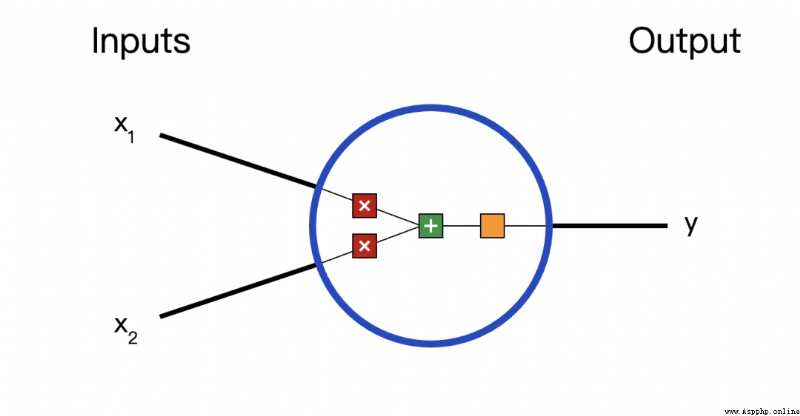
Three things happened here . First , Each input is multiplied by a weight ( Red ):


then , Weighted input summation , Add a deviation b( green ):

Last , This result is passed to an activation function f:

The purpose of the activation function is to put an unbounded input , Transform into a predictable form . The commonly used activation function is S Type of function :
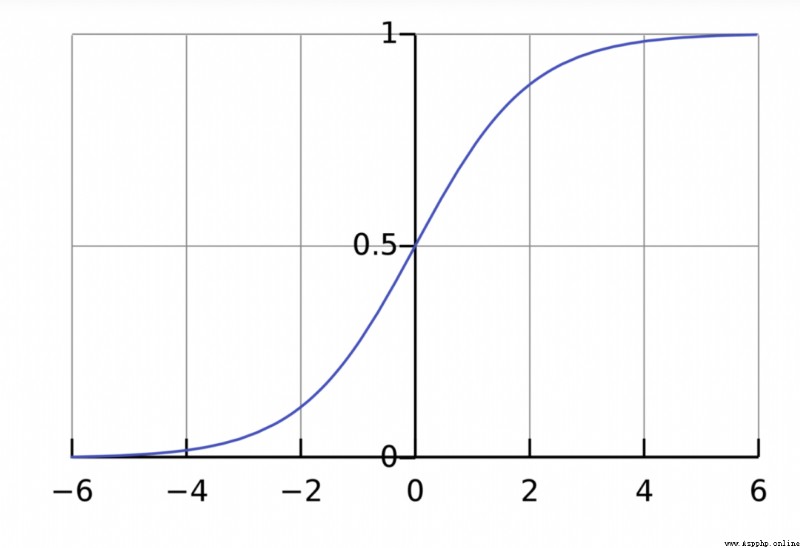
S The range of value of a type function is (0, 1). Simply speaking , Is to put (−∞, +∞) Compress to (0, 1) , A large negative number is about 0, A large positive number is about 1.
Suppose we have a neuron , The activation function is S Type of function , Its parameters are as follows :
w=[0,1],b=4
w=[0,1] It is expressed in the form of vectors w1=0,w2=1. Now? , We give this neuron an input [2,3]. We use dot product to express :

When the input is [2, 3] when , The output of this neuron is 0.999. A given input , The process of getting the output is called feedforward (feedforward).
Let's implement a neuron ! use Python Of NumPy Library to complete the mathematical calculation :
import numpy as np
def sigmoid(x):
# Our activation function : f(x) = 1 / (1 + e^(-x))
return 1 / (1 + np.exp(-x))
class Neuron:
def __init__(self, weights, bias):
self.weights = weights
self.bias = bias
def feedforward(self, inputs):
# Weighted input , Add bias , Then use the activation function
total = np.dot(self.weights, inputs) + self.bias
return sigmoid(total)
weights = np.array([0, 1]) # w1 = 0, w2 = 1
bias = 4 # b = 4
n = Neuron(weights, bias)
x = np.array([2, 3]) # x1 = 2, x2 = 3
print(n.feedforward(x)) # 0.9990889488055994
The so-called neural network is a pile of neurons . This is a simple neural network :
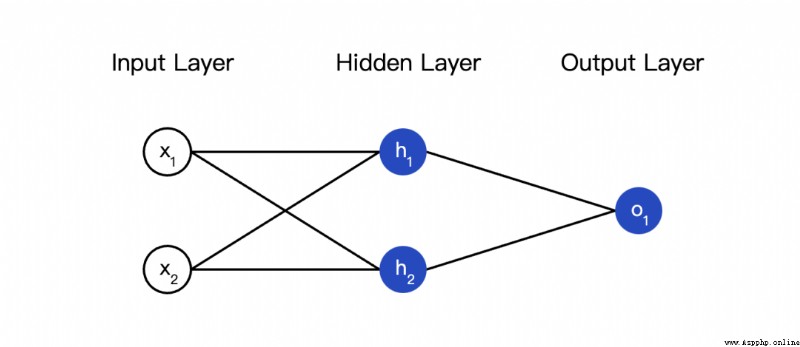
This network has two inputs , One has two neurons (  and
and  ) The hidden layer of , And one has a neuron (
) The hidden layer of , And one has a neuron ( ) ) The output layer of . it is to be noted that ,
) ) The output layer of . it is to be noted that , The input is
The input is  and
and  Output , This forms a network .
Output , This forms a network .
The hidden layer is the layer between the input layer and the output layer , Hidden layers can be multi-layered .
We continue to use the network in the previous figure , Suppose the weight of each neuron is , The intercept term is the same , Activation functions are also S Type of function . Use them separately Represents the output of the corresponding neuron .
When the input x=[2,3] when , What's going to happen ?
This neural network pairs inputs [2,3] The output of is 0.7216, It's simple .
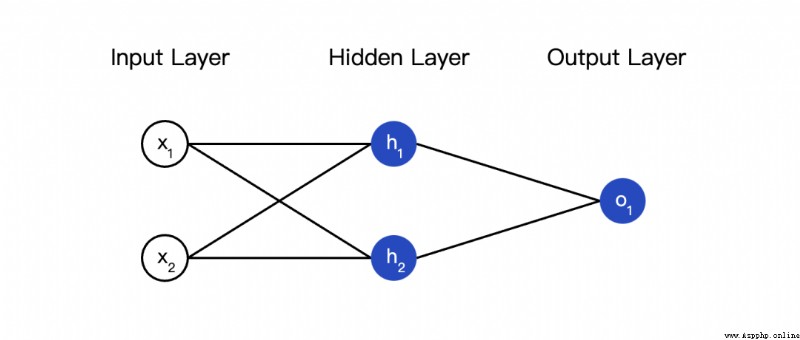
import numpy as np
# ... code from previous section here
class OurNeuralNetwork:
''' A neural network with: - 2 inputs - a hidden layer with 2 neurons (h1, h2) - an output layer with 1 neuron (o1) Each neuron has the same weights and bias: - w = [0, 1] - b = 0 '''
def __init__(self):
weights = np.array([0, 1])
bias = 0
# Here are neurons from the previous section
self.h1 = Neuron(weights, bias)
self.h2 = Neuron(weights, bias)
self.o1 = Neuron(weights, bias)
def feedforward(self, x):
out_h1 = self.h1.feedforward(x)
out_h2 = self.h2.feedforward(x)
# o1 The input is h1 and h2 Output
out_o1 = self.o1.feedforward(np.array([out_h1, out_h2]))
return out_o1
network = OurNeuralNetwork()
x = np.array([2, 3])
print(network.feedforward(x)) # 0.7216325609518421
Results the correct , It doesn't look like a problem .
Now there are such data :
Next, we use this data to train the weight and intercept terms of the neural network , Thus, gender can be predicted according to height and weight :
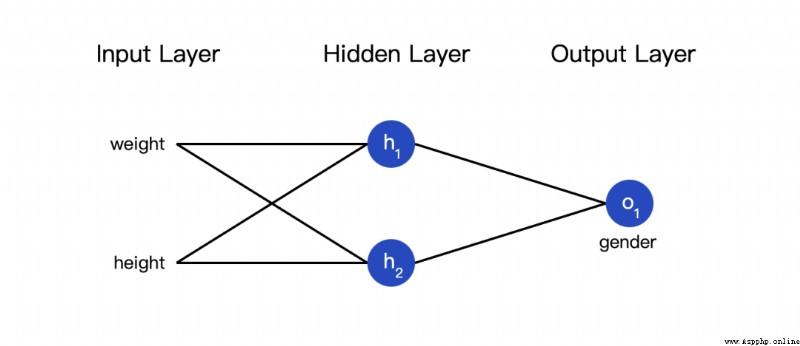
We use it 0 and 1 It means male (M) And women (F), And the numerical value is transformed :
I chose it at random 135 and 66 To standardize data , The average value is usually used .
Before training the web , We need to quantify that the current network is 『 good 』 still 『 bad 』, So we can find a better network . This is the purpose of defining loss .
We use mean variance here (MSE) Loss : , Let's take a closer look :
n Is the number of samples , This is equal to 4(Alice、Bob、Charlie and Diana).
y Represents the variable to be predicted , Here is gender .
 Is the true value of the variable (『 right key 』). for example ,Alice Of
Is the true value of the variable (『 right key 』). for example ,Alice Of  Namely 1( men ).
Namely 1( men ).
 The predicted value of the variable . This is the output of our network .
The predicted value of the variable . This is the output of our network .
 It is called variance (squared error). Our loss function is the average of all variances . Prediction effect Yu Hao , The less you lose .
It is called variance (squared error). Our loss function is the average of all variances . Prediction effect Yu Hao , The less you lose .
Better prediction = Less loss !
Training network = Minimize its loss .
Suppose our network always outputs 0, In other words, think that everyone is male . How about the loss ?

Here is the calculation MSE Lost code :
import numpy as np
def mse_loss(y_true, y_pred):
# y_true and y_pred are numpy arrays of the same length.
return ((y_true - y_pred) ** 2).mean()
y_true = np.array([1, 0, 0, 1])
y_pred = np.array([0, 0, 0, 0])
print(mse_loss(y_true, y_pred)) # 0.5
If you don't understand this code , You can see NumPy Quick start on Array Operations .
Now we have a clear goal : Minimize the loss of Neural Networks . By adjusting the weight and intercept of the network , We can change the prediction results , But how can we gradually reduce losses ?
This paragraph involves multivariate calculus , If you are not familiar with calculus , You can skip these mathematical contents .
This paragraph involves multivariate calculus , If you are not familiar with calculus , You can skip these mathematical contents .
To simplify the problem , Suppose there are only Alice, Then the mean square loss is just Alice The variance of :

Loss can also be regarded as a function of weight and intercept terms . Let's label the network with the terms of weight and intercept :
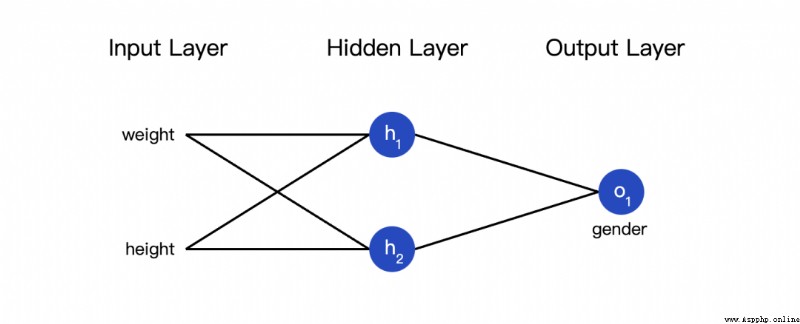
In this way, we can express the loss of the network as :

Suppose we want to optimize  , When we change
, When we change  when , Loss
when , Loss  How will it change ? It can be used
How will it change ? It can be used  To answer this question , How to calculate ?
To answer this question , How to calculate ?
First , Let's use it  To rewrite this Partial derivative :
To rewrite this Partial derivative :

Because we already know  , So we can calculate
, So we can calculate 

Now let's take care of it  .
. Are the outputs of the neurons they represent , We have :
Are the outputs of the neurons they represent , We have :

because  Will only affect
Will only affect  ( Does not affect the
( Does not affect the  ), therefore :
), therefore :


Yes  , We can do the same :
, We can do the same :


ad locum , It's height ,
It's height , It's weight . This is the second time we've seen
It's weight . This is the second time we've seen  (S The derivative of a type function ) 了 . solve :
(S The derivative of a type function ) 了 . solve :


We have  It breaks down into several parts that we can calculate :
It breaks down into several parts that we can calculate :

This method of calculating partial derivatives is called 『 Back propagation algorithm 』(backpropagation).
Many mathematical symbols , If you haven't figured it out , Let's look at a practical example .
Let's look at the data set, only Alice The situation of :
Initialize all weight and intercept terms to 1 and 0. Do feedforward calculation in the network :



The output of the network is  , about Male(0) perhaps Female(1) Not too inclined . Calculate it
, about Male(0) perhaps Female(1) Not too inclined . Calculate it 







Tips : The front has been S Derivative of activation function of type
.
Get it done ! This result means to increase  ,
, It will also rise slightly .
It will also rise slightly .
Now everything is ready to train neural networks ! We will use an optimization algorithm called random gradient descent method to optimize the weight and intercept terms of the network , Minimize losses . The core is this update formula :

 It's a constant , It's called the learning rate , Used to adjust the speed of training . All we have to do is use
It's a constant , It's called the learning rate , Used to adjust the speed of training . All we have to do is use  subtract
subtract 
Our training process is like this :
Select a sample from our data set , Optimize with random gradient descent method —— Each time we optimize only one sample ;
Calculate the partial derivative of each weight or intercept term to the loss ( for example  、
、 etc. );
etc. );
Update each weight and intercept term with the update equation ;
Repeat the first step ;
We can finally realize a complete neural network :
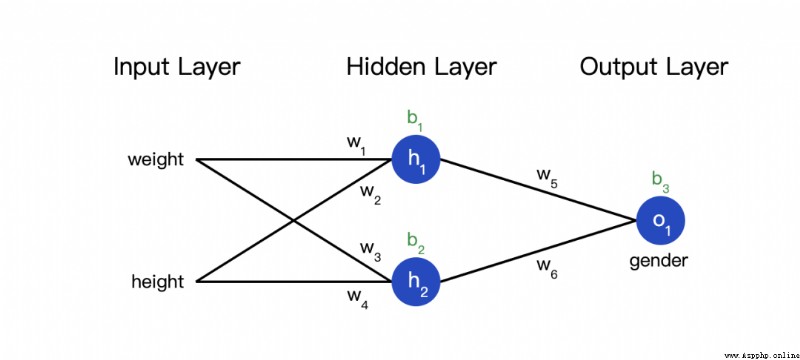
Overall code
import numpy as np
def sigmoid(x):
# Sigmoid activation function: f(x) = 1 / (1 + e^(-x))
return 1 / (1 + np.exp(-x))
def deriv_sigmoid(x):
# Derivative of sigmoid: f'(x) = f(x) * (1 - f(x))
fx = sigmoid(x)
return fx * (1 - fx)
def mse_loss(y_true, y_pred):
# y_true and y_pred It's the same length numpy Array .
return ((y_true - y_pred) ** 2).mean()
class OurNeuralNetwork:
''' A neural network with: - 2 inputs - a hidden layer with 2 neurons (h1, h2) - an output layer with 1 neuron (o1) *** disclaimer ***: The following code is for simplicity and demonstration , Not the best . The real neural network code is completely different . Do not use this code . contrary , read / Run it to understand how this particular network works . '''
def __init__(self):
# The weight ,Weights
self.w1 = np.random.normal()
self.w2 = np.random.normal()
self.w3 = np.random.normal()
self.w4 = np.random.normal()
self.w5 = np.random.normal()
self.w6 = np.random.normal()
# Intercept item ,Biases
self.b1 = np.random.normal()
self.b2 = np.random.normal()
self.b3 = np.random.normal()
def feedforward(self, x):
# X Is a 2 A numeric array of elements .
h1 = sigmoid(self.w1 * x[0] + self.w2 * x[1] + self.b1)
h2 = sigmoid(self.w3 * x[0] + self.w4 * x[1] + self.b2)
o1 = sigmoid(self.w5 * h1 + self.w6 * h2 + self.b3)
return o1
def train(self, data, all_y_trues):
''' - data is a (n x 2) numpy array, n = # of samples in the dataset. - all_y_trues is a numpy array with n elements. Elements in all_y_trues correspond to those in data. '''
learn_rate = 0.1
epochs = 1000 # Number of times to traverse the entire data set
for epoch in range(epochs):
for x, y_true in zip(data, all_y_trues):
# --- Make a feedforward ( We will need these values later )
sum_h1 = self.w1 * x[0] + self.w2 * x[1] + self.b1
h1 = sigmoid(sum_h1)
sum_h2 = self.w3 * x[0] + self.w4 * x[1] + self.b2
h2 = sigmoid(sum_h2)
sum_o1 = self.w5 * h1 + self.w6 * h2 + self.b3
o1 = sigmoid(sum_o1)
y_pred = o1
# --- Calculating partial derivatives .
# --- Naming: d_L_d_w1 represents "partial L / partial w1"
d_L_d_ypred = -2 * (y_true - y_pred)
# Neuron o1
d_ypred_d_w5 = h1 * deriv_sigmoid(sum_o1)
d_ypred_d_w6 = h2 * deriv_sigmoid(sum_o1)
d_ypred_d_b3 = deriv_sigmoid(sum_o1)
d_ypred_d_h1 = self.w5 * deriv_sigmoid(sum_o1)
d_ypred_d_h2 = self.w6 * deriv_sigmoid(sum_o1)
# Neuron h1
d_h1_d_w1 = x[0] * deriv_sigmoid(sum_h1)
d_h1_d_w2 = x[1] * deriv_sigmoid(sum_h1)
d_h1_d_b1 = deriv_sigmoid(sum_h1)
# Neuron h2
d_h2_d_w3 = x[0] * deriv_sigmoid(sum_h2)
d_h2_d_w4 = x[1] * deriv_sigmoid(sum_h2)
d_h2_d_b2 = deriv_sigmoid(sum_h2)
# --- Update weights and deviations
# Neuron h1
self.w1 -= learn_rate * d_L_d_ypred * d_ypred_d_h1 * d_h1_d_w1
self.w2 -= learn_rate * d_L_d_ypred * d_ypred_d_h1 * d_h1_d_w2
self.b1 -= learn_rate * d_L_d_ypred * d_ypred_d_h1 * d_h1_d_b1
# Neuron h2
self.w3 -= learn_rate * d_L_d_ypred * d_ypred_d_h2 * d_h2_d_w3
self.w4 -= learn_rate * d_L_d_ypred * d_ypred_d_h2 * d_h2_d_w4
self.b2 -= learn_rate * d_L_d_ypred * d_ypred_d_h2 * d_h2_d_b2
# Neuron o1
self.w5 -= learn_rate * d_L_d_ypred * d_ypred_d_w5
self.w6 -= learn_rate * d_L_d_ypred * d_ypred_d_w6
self.b3 -= learn_rate * d_L_d_ypred * d_ypred_d_b3
# --- In every time epoch Calculate the total loss at the end
if epoch % 10 == 0:
y_preds = np.apply_along_axis(self.feedforward, 1, data)
loss = mse_loss(all_y_trues, y_preds)
print("Epoch %d loss: %.3f" % (epoch, loss))
# Define datasets
data = np.array([
[-2, -1], # Alice
[25, 6], # Bob
[17, 4], # Charlie
[-15, -6], # Diana
])
all_y_trues = np.array([
1, # Alice
0, # Bob
0, # Charlie
1, # Diana
])
# Train our neural networks !
network = OurNeuralNetwork()
network.train(data, all_y_trues)
With the learning on the Internet , Losses are steadily falling .
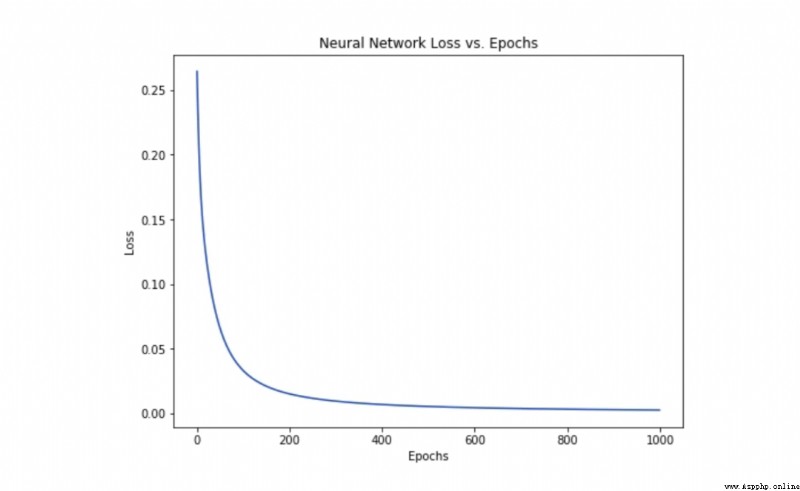
Now we can use this network to predict gender :
# Make some predictions
emily = np.array([-7, -3]) # 128 pounds , 63 Inch
frank = np.array([20, 2]) # 155 pounds , 68 Inch
print("Emily: %.3f" % network.feedforward(emily)) # 0.951 - F
print("Frank: %.3f" % network.feedforward(frank)) # 0.039 - M
Got a simple neural network , A quick review :
The basic structure of neural network is introduced —— Neuron ;
Use in neurons S Type A activation function ;
Neural networks are neurons connected together ;
A data set is constructed , Input ( Or characteristics ) It's weight and height , Output ( Or tags ) It's gender ;
Learned the loss function and mean square error loss ;
Training the network is to minimize its loss ;
Calculate the partial derivative with the back propagation method ;
Use the random gradient descent method to train the network ;
Next you can :
Use machine learning library to realize larger and better neural network , for example TensorFlow、Keras and PyTorch;
Implement neural network in browser ;
Other types of activation functions ;
Other types of optimizers ;
Learn convolutional neural networks , This has revolutionized the field of computer vision ;
Learn recurrent neural networks , Common language naturallanguageprocessing ;
Attach a piece of code
#!/usr/bin/pyton3
import numpy as np
import matplotlib.pyplot as plt
# Activation Function
def sigmoid(x):
return 1 / (1 + np.exp(-x))
# Neural Unit
class Perceptron(object):
def __init__(self, input_size: int, initializer: list = None, activation_func: str = None):
# W[0] is the bias
self.input_size = input_size
# W is parameters of Perceptron
self.n_W = self.input_size + 1
self.W = np.random.uniform(low=0.0, high=1.0, size=self.n_W)
# X is the input vector of Perceptron
self.X = None
self.output = 0.0
self.delta_W = np.array([0] * self.n_W, dtype=np.float)
self.delta_X = np.array([0] * input_size, dtype=np.float)
self.activation_func = activation_func
if initializer:
assert len(initializer) == self.n_W
self.W = initializer
def forward(self, X):
assert len(X) == self.input_size
self.X = np.array(X, dtype=float)
y = np.sum(self.W[1:] * self.X) + self.W[0]
if self.activation_func == 'sigmoid':
self.output = sigmoid(y)
else:
self.output = y
return self.output
def update(self, lr):
self.W = self.W + lr * self.delta_W
self.delta_W = np.array([0] * self.n_W, dtype=np.float)
def __call__(self, X):
return self.forward(X)
# Neural Layer
class Layer(object):
def __init__(self, input_size: int, output_size: int, activation_func='sigmoid', lr=0.1):
self.input_size = input_size
self.output_size = output_size
self.net = np.array(
[Perceptron(input_size=input_size, activation_func=activation_func) for _ in range(output_size)])
self.activation_func = activation_func
self.inputs = np.array([0] * input_size, dtype=np.float)
self.lr = lr
self.outputs = np.array([0] * output_size, dtype=np.float)
def forward(self, X):
self.inputs = np.array(X, dtype=np.float)
self.outputs = np.array([p(X) for p in self.net])
return self.outputs
def __call__(self, X):
return self.forward(X)
def backward(self, delta_outputs):
assert len(delta_outputs) == len(self.net)
for idx in range(self.output_size):
delta_output = delta_outputs[idx]
p = self.net[idx]
o = self.outputs[idx]
if self.activation_func == 'sigmoid':
# W0 is the bias
p.delta_W = delta_output * o * (1 - o) * np.array([1] + list(p.X)) # expand X for W_0
p.delta_X = delta_output * o * (1 - o) * p.W[1:]
else:
# linear
p.delta_W = delta_output * np.array([1] + list(p.X))
# W0 is the bias
p.delta_X = delta_output * p.W[1:]
def update(self):
for p in self.net:
p.update(self.lr)
if __name__ == '__main__':
# standard version ============================
samples = [[[-2, -1], 1],
[[25, 6], 0],
[[17, 4], 0],
[[-15, -6], 1]]
# training
layer1 = Layer(2, 10)
layer2 = Layer(10, 1, activation_func='')
for i in range(1000):
# iteration
print(f'iteration {
i}')
text_X = samples[3][0]
text_y_d = samples[3][1]
test_y = layer2(layer1((samples[3][0])))[0]
print(f'X:{
text_X}, y_d:{
text_y_d}, y:{
test_y}')
for X, y_d in samples:
# forward
y = layer2(layer1(X))[0]
# backward layer2 -> layer1
err = y_d - y # delta_outputs of layer 2
layer2.backward([err])
delta_outputs = np.array([0.0] * layer2.input_size, dtype=np.float) # delta_outputs of layer 1
for p in layer2.net:
delta_outputs += p.delta_X
layer1.backward(delta_outputs)
# update gradient
layer2.update()
layer1.update()
# result
for X, y_d in samples:
y = layer2(layer1(X))[0]
print(f'The final result: X:{
X}, y_d:{
y_d}, y:{
y}')
# # simple version ============================
# samples = [[[0, 1], 1],
# [[1, 0], -1]]
# # training
# layer1 = Layer(2, 1, activation_func='')
# for i in range(100):
# # iteration
# print(f'iteration {i}')
# for X, y_d in samples:
# # forward
# y = layer1(X)[0]
# # backward
# err = y_d - y
# layer1.backward([err])
# print(f'W:{layer1.net[0].W}')
# print(f'delta_W:{layer1.net[0].delta_W}')
# layer1.update()
# print(f'X:{X}, y_d:{y_d}, y:{y}')